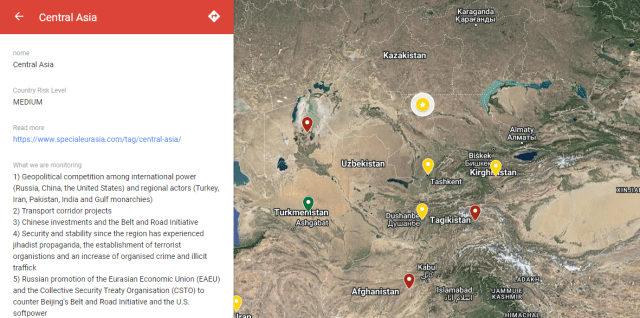Central Asian republics between socio-economic projects, popular protests, terrorist threats and the Afghan dilemma

Author: Giuliano Bifolchi
Central Asian republics want to establish solid regional cooperation to promote socio-economic projects to stabilise the area and contrast rising problems such as widespread disappointment and protests, terrorist threats and security issues related to the current situation in Afghanistan.
On July 21st, 2022, the Kyrgyz city of Cholpon-Ata hosted the IV Consultative Meeting of the Heads of State of Central Asia. During the meeting, the presidents of Kazakhstan (Kassym-Jomart Tokayev), Uzbekistan (Shavkat Mirziyoyev), and Kyrgyzstan (Sadir Japarov) signed the Treaty of Friendship, Good Neighborliness and Cooperation for the Development of CentralAsia in the 21st century. According to different local sources, in the future, Tajikistan and Turkmenistan might join the Treaty.
The Central Asian leaders stressed that the region should become a vast socio-economic development and broad cooperation area. As the Central Asian leaders noted commenting on the meeting in Cholphon-Ata, Central Asian republics need to overcome the current crisis conditions that the region is experiencing, such as popular disappointment, legal jurisdictional border issues, terrorist threats and the impact of the Afghan situation.
Geopolitical scenario
Since the U.S. troops’ withdrawal from Afghanistan and the Taliban’s rise to power in Kabul, the geopolitical risk of Central Asia has risen due to the fear that the Afghan territory could become a springboard for various terrorist groups interested in operating in the region. Indeed, under the Taliban rule, Kabul has not proven its ability to contrast jihadist propaganda and terrorist activities carried out by several terrorist groups, especially the Islamic State Khurasan Province (ISKP) (Uncertainty and instability in contemporary Afghanistan).
Since the beginning of 2022, Central Asia has been under the spotlight of international media due to local protests caused by economic problems, distrust of the central authority, internal political confrontation, and ethnic minorities-government relations.
In January 2022, Kazakhstan had to cope with large protests, pushing Kazakh president Kassym-Jomart Tokayev to request the Collective Security Treaty Organisation (CSTO) military intervention to contrast what Nur-Sultan called ‘foreign agents and terrorist attempts to destabilise the country’ (Geopolitical consequences of the political crisis in Kazakhstan).
In May 2022, in the strategic Gorno-Badakhshan Autonomous Region (GBAO), local people protested against the central authority, asking for the mayor’s resignation and the end of the persecution against Badakhshan residents. Consequently, the Government launched an anti-terrorist operation to contrast members of organised international terrorist groups who illegally blocked the Dushanbe-Khorugh-Kulma international highway on a section in the Rushan region with the final goal to destabilise the regional socio-political situation (Political tensions and security threats in Tajikistan).
At the beginning of July 2022, the Uzbek Government had to manage the large protests organised in the autonomous Republic of Karakalpakstan against proposed changes to the Constitution of Uzbekistan, which, according to Karakalpak residents, would have limited local autonomy. Also, in this case, the central authority launched a military operation in GBAU, claiming that ‘criminal groups’ and ‘terrorist organisations’ tried to exploit the situation (Mass riots and protests in the Uzbek autonomous Republic of Karakalpakstan).
Looking at the broad geopolitical picture of Central Asia, several regional and international actors are interested in the area and might influence the local socio-economic and political process. Furthermore, since the Taliban took power in Kabul, the terrorist threat has become more tangible in the region, particularly after the Islamic State Khurasan Province (ISKP) started a jihadist propaganda campaign to recruit Tajik, Uzbek, and Kyrgyz foreign fighters and volunteers (Islamic State Khurasan Province threatens Uzbekistan, Central Asia, and neighbouring countries).
Risk assessment
Central Asian republics need regional stability to promote socio-economic development and raise local living standards, which are fundamental to avoid future protests and considerable local disappointment. Therefore, Central Asian states have balanced their foreign and economic policies between regional powers such as the Russian Federation, China and Turkey and international actors such as the European Union, the United States and Gulf Arab monarchies to achieve their goal.
Since the beginning of the Ukraine conflict in February 2022, Central Asia republics’ strategy to balance among global powers, particularly Russia and the West, has become a significant challenge due to Moscow, Washington and Brussels’ pressures. Looking at the Central Asian geopolitical chessboard, it is undeniable that Beijing and Moscow play a decisive and strategic role in regional dynamics.
China has a substantial economic presence in Central Asia, and Beijing has invested copious financial funds in local infrastructural projects to support its Belt and Road Initiative (Central Asian republics’ economic dependence on China).
Russia has a solid political, military and historical link with Central Asia, which is part of the Russian blizhnee zarubezhe (near abroad), where Moscow established the Eurasian Economic Union (EAEU) and the Collective Security Treaty Organisation (CSTO) and tried to promote more significant military and political cooperation (CIS countries strengthened military cooperation).
In recent years, Turkey has emphatically promoted its Pan-Turkism and the idea of creating a Turkic geopolitical bloc among the Caucasus and Central Asia, which might confront Moscow’s Eurasian Economic Union, Beijing’s Belt and Road Initiative, Brussels and Washington’s regional strategies and the rise of Gulf Arab monarchies in Central Asian financial market (Turkey and pan-Turkism in Central Asia: challenges for Russia and China).
In this framework, local authoritarianism, corruption, and economic problems, fuelled by external forces interested in promoting their geopolitical agenda (Central Asian security problems: authoritarianism, economic crisis and foreign influence), might create friction or exacerbate the situation in border areas or autonomous regions and push local young generations to look at jihadist terrorist groups and radicalisation as the only solution to their problems.
Since near Afghanistan still lacks stability and the Taliban government has not successfully contrasted the Islamic State, if local governments will not implement socio-economic projects, the Central Asian area might become more destabilised and negatively affect those foreign entrepreneurs who have invested in the regional market, which has the potential to become a logistic hub between Europe and Asia.
